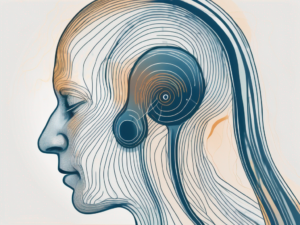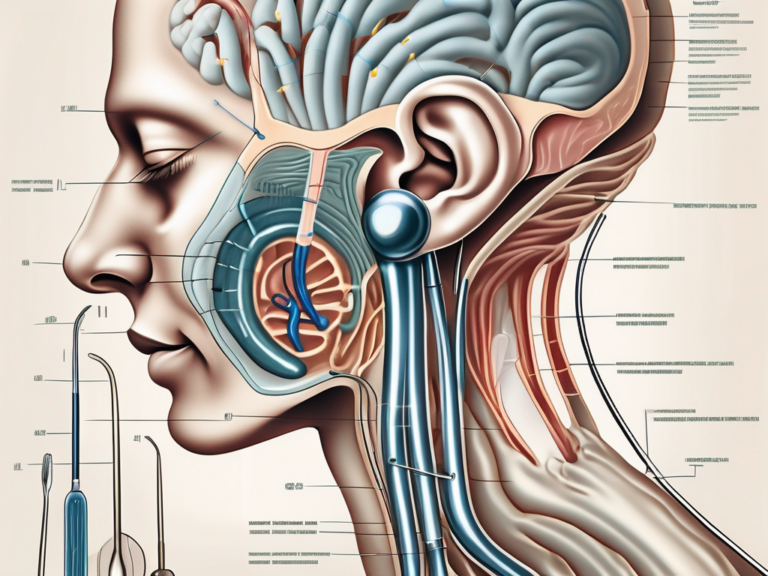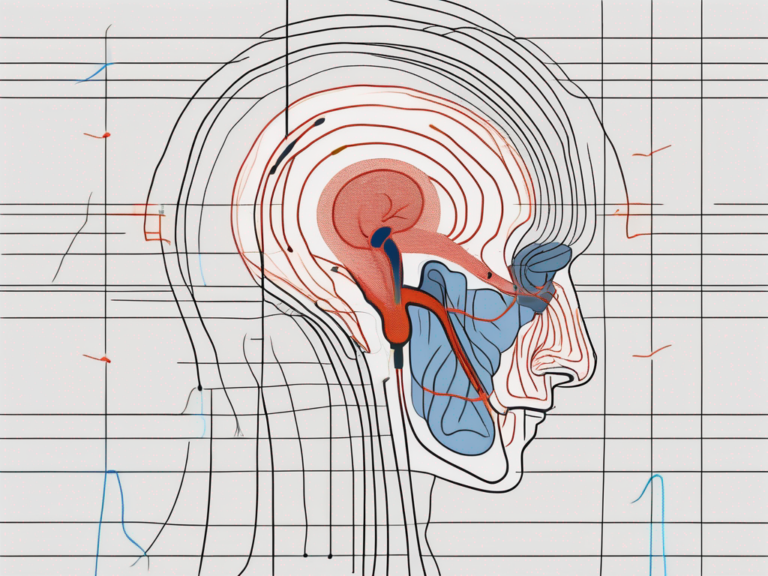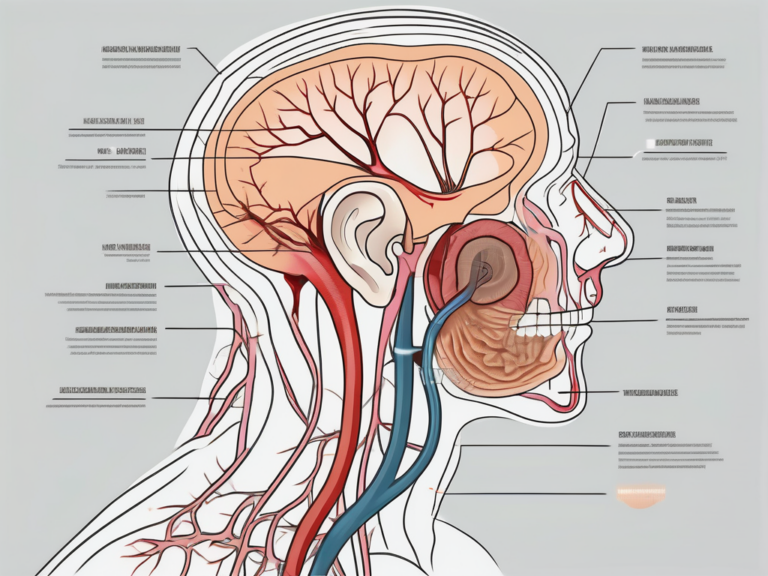The vestibular nerve is an essential component of our body’s intricate sensory system. It plays a crucial role in our sense of balance and spatial orientation. Understanding the function and significance of the vestibular nerve is key to appreciating its impact on our daily lives.
Understanding the Vestibular Nerve
The vestibular nerve, also known as the eighth cranial nerve or the vestibulocochlear nerve, is located within the inner ear. It is responsible for transmitting sensory information about our head’s position and movement to the brain. This information helps us maintain our balance, stabilize our gaze, and adjust our posture accordingly.
Anatomy of the Vestibular Nerve
The vestibular nerve consists of two main branches: the superior and inferior divisions. These branches connect to different components of the inner ear, including the semicircular canals and the otolith organs. The semicircular canals detect rotational movements, while the otolith organs perceive linear movements and the effects of gravity.
The semicircular canals are three fluid-filled structures that are oriented in different planes. They are responsible for detecting rotational movements of the head. Each canal is filled with a fluid called endolymph, and when the head rotates, the movement of the endolymph stimulates hair cells within the canals. These hair cells then send signals through the vestibular nerve to the brain, providing information about the direction and speed of the head’s rotation.
The otolith organs, on the other hand, are responsible for perceiving linear movements and the effects of gravity. They consist of two structures called the utricle and the saccule, which are filled with a gel-like substance containing tiny calcium carbonate crystals called otoliths. When the head moves in a linear direction or when the head is tilted, the otoliths shift, bending hair cells and generating signals that are transmitted through the vestibular nerve to the brain. This information helps the brain determine the head’s position in space and make necessary adjustments to maintain balance.
Functions of the Vestibular Nerve
The primary function of the vestibular nerve is to transmit sensory signals related to balance and spatial orientation to the brain. This input allows the brain to maintain equilibrium by coordinating and adjusting our body’s movements. By integrating information from the vestibular system with visual and proprioceptive cues, the brain ensures our stability and prevents us from enduring falls.
In addition to its role in balance, the vestibular nerve also contributes to the vestibulo-ocular reflex (VOR). The VOR is a reflex that enables our eyes to remain focused on a target while our head is in motion. This reflex is crucial for maintaining clear and stable vision, especially during activities such as walking, running, or driving. When the head moves, signals from the vestibular system are sent to the brainstem, which in turn sends commands to the muscles that control eye movement. These commands ensure that our visual perception remains steady even during rapid head movements or when we are exposed to external disturbances.
Furthermore, the vestibular nerve plays a role in spatial awareness and spatial memory. The information it provides to the brain helps us navigate our surroundings, orient ourselves in space, and remember the layout of our environment. This is particularly important for activities such as driving, playing sports, or simply walking in crowded places.
In summary, the vestibular nerve is a crucial component of our sensory system, responsible for transmitting information about head position, movement, and spatial orientation to the brain. Its functions extend beyond balance, contributing to the vestibulo-ocular reflex and spatial awareness. Understanding the intricacies of the vestibular nerve helps us appreciate the complexity of our body’s mechanisms for maintaining equilibrium and perceiving the world around us.
The Role of the Vestibular Nerve in Balance
The vestibular nerve’s connection to the inner ear is crucial for maintaining balance and equilibrium. These biological mechanisms work together seamlessly to provide us with a profound sense of stability and spatial awareness.
Connection between the Vestibular Nerve and the Inner Ear
The vestibular nerve’s nerve fibers are intricately intertwined with the intricate structures of the inner ear, particularly the semicircular canals and the otolith organs. The semicircular canals are fluid-filled channels that detect rotational movements, while the otolith organs sense linear accelerations and the effects of gravity.
Within the semicircular canals, there are three fluid-filled loops positioned at different angles to detect movements in different planes. Each loop contains specialized hair cells that are sensitive to the movement of the fluid. When the head rotates, the fluid inside the canals shifts, causing the hair cells to bend. This bending stimulates the hair cells to send electrical signals through the vestibular nerve to the brain.
The otolith organs, on the other hand, consist of two structures called the utricle and the saccule. These organs contain tiny crystals called otoliths, which are attached to hair cells. When the head moves in a linear direction or experiences the force of gravity, the otoliths move, bending the hair cells and generating electrical signals that are transmitted through the vestibular nerve.
Together, the semicircular canals and otolith organs provide the brain with detailed information about the head’s position, orientation, and movement in space.
How the Vestibular Nerve Communicates with the Brain
The vestibular nerve serves as a vital bridge between the inner ear and the brain. The nerve fibers transmit sensory information from the inner ear’s receptors to specific regions within the brain, such as the brainstem and the cerebellum.
Once these signals reach the brain, various neural pathways process and interpret the information. This complex network integrates the sensory data received from the vestibular nerve with visual and proprioceptive feedback to generate a comprehensive understanding of our body’s position and movement in space.
The brainstem plays a crucial role in receiving and relaying vestibular information. It receives signals from the vestibular nerve and sends them to other parts of the brain for further processing. The cerebellum, known for its role in motor coordination, also receives vestibular input and uses it to fine-tune movements and maintain balance.
Furthermore, the vestibular system interacts with other sensory systems to provide a holistic perception of our surroundings. Visual input from the eyes and proprioceptive feedback from muscles and joints are integrated with vestibular information to create a coherent representation of our body’s position and motion.
In summary, the vestibular nerve’s connection to the inner ear and its communication with the brain are essential for our ability to maintain balance, coordinate movements, and navigate our environment with confidence.
Disorders Related to the Vestibular Nerve
While the vestibular nerve plays a vital role in our everyday functioning, certain disorders can disrupt its normal functioning. These disorders can have a significant impact on our balance, coordination, and overall quality of life.
The vestibular nerve, also known as the eighth cranial nerve or the vestibulocochlear nerve, is responsible for transmitting sensory information from the inner ear to the brain. It helps us maintain our sense of balance and spatial orientation, allowing us to navigate the world around us with ease.
However, when the vestibular nerve is affected by a disorder, it can lead to a range of symptoms that can be debilitating and affect our daily activities. These disorders can be caused by various factors, including infections, trauma, tumors, or even certain medications.
Symptoms of Vestibular Nerve Disorders
Vestibular nerve disorders can manifest in various ways, and individuals may experience different symptoms depending on the specific condition. Common symptoms of vestibular nerve disorders include dizziness, vertigo, imbalance, nausea, and difficulties with coordination. Some individuals may also experience hearing loss or tinnitus.
Dizziness is a common symptom experienced by individuals with vestibular nerve disorders. It can range from a mild sensation of lightheadedness to a severe spinning sensation that can make it difficult to perform daily tasks. Vertigo, on the other hand, is a specific type of dizziness characterized by a spinning or whirling sensation, often accompanied by nausea and vomiting.
Imbalance and difficulties with coordination are also common symptoms of vestibular nerve disorders. These symptoms can make it challenging to walk or perform activities that require precise movements, such as driving or playing sports. Hearing loss and tinnitus, a ringing or buzzing sound in the ears, can also occur due to the involvement of the vestibulocochlear nerve.
If you experience any of these symptoms or suspect a vestibular nerve disorder, it is crucial to seek medical attention. A healthcare professional can conduct a comprehensive evaluation and guide you towards an accurate diagnosis and appropriate treatment options.
Diagnosis and Treatment of Vestibular Nerve Disorders
Diagnosing vestibular nerve disorders typically involves a thorough assessment of medical history, physical examination, and specialized tests. These tests may include electronystagmography (ENG), magnetic resonance imaging (MRI), or vestibular evoked myogenic potentials (VEMPs).
Electronystagmography is a test that measures eye movements to evaluate the function of the vestibular system. Magnetic resonance imaging uses powerful magnets and radio waves to create detailed images of the brain and inner ear, helping to identify any structural abnormalities. Vestibular evoked myogenic potentials measure the electrical responses of certain muscles in response to sound or other stimuli, providing information about the function of the vestibulocochlear nerve.
The treatment for vestibular nerve disorders depends on the underlying cause and severity of the condition. In some cases, medication or vestibular rehabilitation therapy may be recommended. Medications can help alleviate symptoms such as dizziness and nausea, while vestibular rehabilitation therapy involves exercises and techniques to improve balance and reduce symptoms.
Surgical intervention may be necessary in rare instances when conservative approaches fail to address the problem effectively. Surgery may involve removing tumors or repairing structural abnormalities that are causing the vestibular nerve disorder.
It is important to remember that self-diagnosis and self-medication are strongly discouraged. Each individual’s situation is unique, and a healthcare professional can provide personalized guidance and treatment options based on a comprehensive evaluation.
The Impact of Vestibular Nerve Damage
Vestibular nerve damage can significantly affect an individual’s quality of life, leading to functional limitations and emotional distress. Understanding the causes and implications of vestibular nerve damage is crucial for developing appropriate management strategies and ensuring optimal rehabilitation outcomes.
Vestibular nerve damage can have far-reaching consequences, affecting various aspects of an individual’s life. From simple tasks like walking and maintaining balance to more complex activities such as driving or participating in sports, the impact of vestibular nerve damage can be profound. The loss of vestibular function can lead to dizziness, vertigo, and a constant feeling of imbalance, making even the simplest of movements challenging and potentially dangerous.
Furthermore, the emotional toll of vestibular nerve damage should not be overlooked. The constant fear of falling or experiencing sudden bouts of dizziness can lead to anxiety and depression. The loss of independence and the need for ongoing management can also take a toll on an individual’s mental well-being.
Causes of Vestibular Nerve Damage
Vestibular nerve damage can result from various factors, including infections, head injuries, tumors, and certain medical conditions. Infections like vestibular neuritis and labyrinthitis can lead to inflammation and damage to the vestibular nerve. These infections can be caused by viral or bacterial agents and often result in sudden and severe vertigo, accompanied by nausea and vomiting.
Traumatic head injuries or tumors may exert pressure on the nerve, causing impairment. Head injuries, such as concussions or skull fractures, can disrupt the delicate structures of the inner ear, including the vestibular nerve. Tumors, both benign and malignant, can grow near or on the vestibular nerve, leading to compression and damage.
Additionally, certain medical conditions, such as Meniere’s disease or acoustic neuroma, can also impact the vestibular nerve’s integrity. Meniere’s disease is a chronic condition characterized by recurring episodes of vertigo, hearing loss, and tinnitus. Acoustic neuroma, on the other hand, is a benign tumor that develops on the vestibular nerve and can cause a range of symptoms, including dizziness and balance problems.
Rehabilitation and Recovery from Vestibular Nerve Damage
Rehabilitation is a key component of managing vestibular nerve damage. Vestibular rehabilitation therapy, administered by skilled healthcare professionals, aims to improve balance, reduce symptoms, and enhance overall functioning. This therapy generally involves exercises and maneuvers targeting specific vestibular-related deficits, accompanied by adaptation and habituation techniques.
During vestibular rehabilitation therapy, individuals undergo a series of exercises designed to gradually expose them to movements and situations that trigger their symptoms. This exposure helps the brain adapt and compensate for the damaged vestibular system, ultimately reducing dizziness and improving balance. The exercises may include head movements, eye exercises, and balance training.
It is important to note that recovery from vestibular nerve damage varies among individuals. Some may experience partial or complete recovery, while others may require ongoing management strategies to navigate daily life. A healthcare professional with expertise in vestibular rehabilitation can provide guidance and support throughout the recovery process.
In addition to rehabilitation therapy, individuals with vestibular nerve damage may benefit from assistive devices and modifications to their environment. For example, using walking aids, such as canes or walkers, can provide additional support and stability. Home modifications, such as installing handrails or grab bars, can also help prevent falls and promote safety.
Furthermore, counseling and support groups can play a crucial role in the recovery process. Connecting with others who have experienced similar challenges can provide a sense of understanding and validation. Sharing experiences and coping strategies can also help individuals navigate the emotional and psychological aspects of living with vestibular nerve damage.
The Vestibular Nerve and Aging
As we age, various physiological changes occur within our bodies, including those affecting the vestibular nerve. Understanding the specific alterations associated with aging can help individuals navigate age-related vestibular changes effectively.
Changes in the Vestibular Nerve Over Time
With advancing age, the vestibular nerve’s function may diminish due to a combination of factors. Degenerative changes in the inner ear, reduced blood flow, and a decline in the number of sensory hair cells can all contribute to age-related vestibular alterations.
These changes can result in decreased balance, increased susceptibility to dizziness or vertigo, and difficulties with spatial orientation. However, it is important to note that while age-related changes are common, not everyone experiences significant disruptions in their daily functioning.
Managing Age-Related Vestibular Nerve Issues
If you are experiencing age-related vestibular changes, it is essential to take proactive steps to manage these issues effectively. Regular physical activity, including balance exercises and routines recommended by healthcare professionals, can help improve overall balance and reduce the risk of falls. Ensuring proper lighting, removing tripping hazards, and maintaining a safe home environment can also mitigate the impact of vestibular changes.
It is advisable to consult with a healthcare professional, such as an otolaryngologist or a vestibular specialist, if you have concerns about age-related vestibular changes. These experts can evaluate your specific condition, provide personalized recommendations, and suggest appropriate management strategies to optimize your well-being.
Conclusion
The vestibular nerve is a fundamentally important component of our sensory system, contributing to our sense of balance and spatial awareness. Its intricate connection to the inner ear and its role in transmitting sensory information to the brain enable us to maintain equilibrium and adjust our body’s movements accordingly. While certain disorders and age-related changes can impact the vestibular nerve’s functioning, seeking appropriate medical attention and adopting management strategies can help individuals effectively navigate these challenges. By understanding the function and significance of the vestibular nerve, we can gain insights into how this critical component influences our everyday lives.









+ There are no comments
Add yours